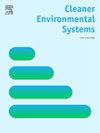Life cycle assessment of clinker and cement production in Spain. Environmental assessment of decarbonisation measures
IF 4.9
Q2 ENGINEERING, ENVIRONMENTAL
引用次数: 0
Abstract
This study examines the environmental impacts of clinker and cement production in Spain, focusing on the effects of current practices and future decarbonisation strategies through a cradle-to-gate life cycle assessment (LCA). Three scenarios were analysed: the baseline scenario, which uses global statistical data on the production and consumption of raw materials and energy in Spain in 2021, and two future scenarios for 2030 and 2050. The impact of implementing various decarbonisation measures proposed in the Spanish cement sector roadmap was evaluated and analysed in the future scenarios. These measures primarily include substituting fossil fuels with biomass- and waste-derived fuels, improving thermal efficiency, and reducing the clinker-to-cement ratio. The results showed that, in six out of the eleven environmental impact categories assessed, impacts were reduced, while increases were observed in the remaining five categories. Global Warming Potential stands out among the categories with reduced impacts, with reductions of 18 % and 36 % projected for cement production in 2030 and 2050, respectively. On the other hand, the categories that showed increased impacts are mainly associated with the greater use of biomass-derived fuels, suggesting the convenience of further exploring their potential implications on the sector's overall environmental performance.
西班牙熟料和水泥生产的生命周期评价。脱碳措施的环境评估
本研究考察了西班牙熟料和水泥生产对环境的影响,通过摇篮到门的生命周期评估(LCA),重点关注当前实践和未来脱碳战略的影响。分析了三种情景:基线情景,使用2021年西班牙原材料和能源生产和消费的全球统计数据,以及2030年和2050年的两种未来情景。在未来的情景中,对实施西班牙水泥行业路线图中提出的各种脱碳措施的影响进行了评估和分析。这些措施主要包括用生物质和废物衍生燃料替代化石燃料,提高热效率,降低熟料与水泥的比例。结果表明,在评估的11个环境影响类别中,有6个类别的影响有所减少,而其余5个类别的影响有所增加。全球变暖潜力在影响减少的类别中脱颖而出,预计到2030年和2050年,水泥产量将分别减少18%和36%。另一方面,影响增加的类别主要与更多地使用生物质衍生燃料有关,这表明进一步探索其对该部门整体环境绩效的潜在影响是方便的。
本文章由计算机程序翻译,如有差异,请以英文原文为准。
求助全文
约1分钟内获得全文
求助全文
来源期刊

Cleaner Environmental Systems
Environmental Science-Environmental Science (miscellaneous)
CiteScore
7.80
自引率
0.00%
发文量
32
审稿时长
52 days
 求助内容:
求助内容: 应助结果提醒方式:
应助结果提醒方式:


